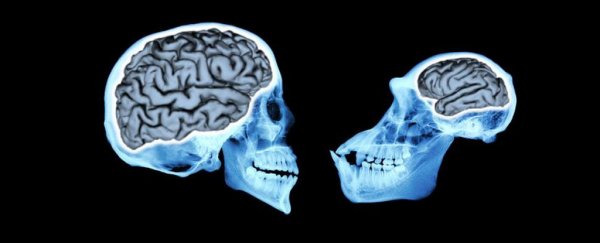Over the millions of years since human and chimp ancestors parted ways, our brains have virtually tripled in size, while theirs have barely budged. Sure, some days it doesn't feel like it, but the fact Homo sapiens have relatively large brains isn't up for discussion.
What is debatable is just how they got to their extraordinary volume. Now researchers have developed a model showing our grey matter evolved steadily over time, making it unlikely that our smarts were selected by any particular behaviour.
There's no shortage of guesses as to why the endocranial volume (ECV) of hominins increased to the degree it did over the past half a dozen or so million years.
"The earliest hominins had brain sizes like chimpanzees, and they have increased dramatically since then. So, it's important to understand how we got here," says Andrew Du, a palaeobiologist from the University of Chicago.
A number of hypotheses rely on changes in diet, better blood flow, or metabolic shifts to power the added neurons.
These explanations do a good job of suggesting how we might have overcome the hurdle of feeding a ravenous nervous system, but they don't say a great deal about forces that helped select for bigger-brained specimens.
Did bigger brains help us better for making friends, as some suggest? Or did they give some ancestors the edge in problem solving?
If this new study is anything to go by, we can't look to any one, simple behaviour for an explanation.
"The conventional wisdom was that our large brains had evolved because of a series of step-like increases each one making our ancestors smarter," says Bernard Wood from George Washington University, who is the senior author on the study.
"Not surprisingly the reality is more complex, with no clear link between brain size and behaviour."
To better understand how our brains went from chimpanzee-petite to the mighty bulk of modern humans, the team compared existing research on the ECVs of 94 fossil specimens representing over a dozen hominin species branching off from our ancestral family tree.
Far from being studied as a line of descent ranging from the 3.2 million year old Australopithecus to our close cousin Homo erectus - who lived just half a million years ago - the specimens were divided into their family lineages, or clades.
This allowed the researchers to compare changes down each branch, as well as across different branches.
What they saw was evolution within each group nudged brain size up gradually. To borrow Du's analogy, it's like a footballer hitting the gym, slowly bulking up their muscles throughout a season.
"But we also see speciation events adding larger-brained daughter species, or recruiting bigger players," says Du.
"And we see extinction, or cutting the smallest players too."
In other words, as hominin species rose and hominin species fell, the smaller brained populations slowly replaced by larger brained ones.
All the while, the brain volumes within each species continuously expanded with the generations.
The study doesn't go so far as to speculate on what forces pushed the gradual change in brain volume. But it does help limit hypotheses to those that are compatible with a slow, steady increase rather than sudden, rapid steps.
Brain size also isn't the be-all and end-all of cognitive functioning. While having more neurons to play with might offer more opportunities to develop added skills, the connections between them are vital in determining brain functionality.
Unfortunately there's only so much we can learn by studying the inside of our ancestor's skulls. At least improved models such as this one will help us squeeze as much information as we can from the fossil record.
This research was published in Proceedings of the Royal Society B.
